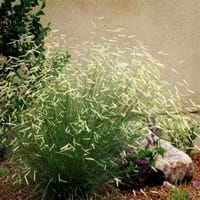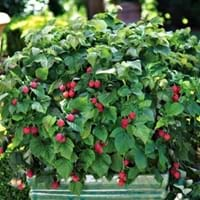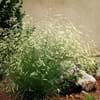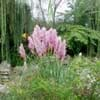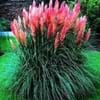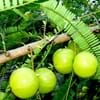Life Span
Annual and Perennial
Perennial
Origin
North America, United States, Western United States, Southwestern United States, Mexico
Hybrid origin
Types
Not Available
not available
Habitat
Open Plains, Prairies
disturbed sites, Forest edges, old gardens, Riverbanks, Roadsides
USDA Hardiness Zone
3-9
4-9
Sunset Zone
1a, 1b, 2a, 2b, 3a, 3b, 7, 8, 9, 10, 11, 14, 18, 19, 20, 21
A1, A2, A3, 1a, 1b, 2a, 2b, 3a, 3b, 4, 5, 6, 7, 8, 9, 10, 11, 12, 13, 14, 15, 16, 17, 18, 19, 20, 21, 22, 23, 24
Habit
Clump-Forming
Upright/Erect
Flower Color
Blue Violet
White
Flower Color Modifier
Bicolor
Bicolor
Fruit Color
Not Available
Red
Leaf Color in Spring
Green, Blue Green
Green
Leaf Color in Summer
Light Green
Green
Leaf Color in Fall
Purple, Blue Green, Tan
Green
Leaf Color in Winter
Not Available
Light Green
Leaf Shape
Grass like
Spade shaped
Plant Season
Summer, Fall, Winter
Spring, Summer, Fall
Sunlight
Full Sun, Partial Sun
Full Sun, Partial Sun
Type of Soil
Clay, Loam, Sand
Loam, Sand
The pH of Soil
Neutral, Alkaline
Acidic, Neutral
Soil Drainage
Well drained
Well drained
Bloom Time
Summer, Late Summer
Spring, Summer
Tolerances
Pollution, Drought
Drought
Where to Plant?
Ground
Container, Ground, Pot
How to Plant?
Seedlings
Seedlings, Stem Planting, Transplanting
Plant Maintenance
Medium
Medium
Watering Requirements
Average Water Needs, Medium
Do Not over Water, Keep ground moist
In Summer
Lots of watering
Lots of watering
In Spring
Moderate
Moderate
In Winter
Average Water
Average Water
Soil pH
Neutral, Alkaline
Acidic, Neutral
Soil Type
Clay, Loam, Sand
Loam, Sand
Soil Drainage Capacity
Well drained
Well drained
Sun Exposure
Full Sun, Partial Sun
Full Sun, Partial Sun
Pruning
No pruning needed
Remove damaged leaves, Remove dead branches, Remove dead leaves
Fertilizers
All-Purpose Liquid Fertilizer
All-Purpose Liquid Fertilizer
Pests and Diseases
Red blotch
Red blotch
Plant Tolerance
Drought, Pollution
Drought
Flower Petal Number
Single
Single
Foliage Texture
Fine
Medium
Foliage Sheen
Matte
Matte
Attracts
Butterflies, Flying insects
Butterflies
Allergy
Anaphylaxis, Asthma, Hay fever, Pollen, Respiratory problems, Runny nose, Watery eyes
Skin rash
Aesthetic Uses
Ground Cover
Showy Purposes
Beauty Benefits
Not Available
Good for skin
Environmental Uses
Air purification, soil erosion prevension on hill slopes, Wildlife
Not Available
Medicinal Uses
Cuts
Sore throat, Ulcers, Wounds
Part of Plant Used
Seeds, Whole plant
Fruits
Other Uses
Used As Food
Edible syrup, Used As Food, Used as Ornamental plant
Used As Indoor Plant
No
No
Used As Outdoor Plant
Yes
Yes
Garden Design
Dried Flower/Everlasting, Feature Plant, Mixed Border, Rock Garden / Wall, Wildflower
Edible, Fruit / Fruit Tree, Hedges
Botanical Name
BOUTELOUA gracilis 'Blonde Ambition'
RUBUS 'Amity'
Common Name
Blonde Ambition Blue Grama Grass, Blue Grama Grass
Amity Raspberry, Raspberry
In Hindi
Blue Grama Grass
Raspberry
In German
Blau Grama Grass
Himbeere
In French
Boutelou gracieux
Framboise
In Spanish
Azul Grama Grass
Frambuesa
In Greek
Μπλε Grama Grass
Βατόμουρο
In Portuguese
Azul Grama Grama
Framboesa
In Polish
Niebieski Grama Trawa
Malina
In Latin
Blue Grama Grass
RUBUS IDAEUS
Phylum
Magnoliophyta
Anthophyta
Class
Lilopsida
Eudicotyledones
Clade
Angiosperms, Commelinids, Monocots
Not Available
Tribe
Not Available
Not Available
Subfamily
Not Available
Not Available
Importance of Blue Grama Grass and Raspberry
Want to have the most appropriate plant for your garden? You might want to know the importance of Blue Grama Grass and Raspberry. Basically, these two plants vary in many aspects. Compare Blue Grama Grass and Raspberry as they differ in many characteristics such as their life, care, benefits, facts, etc. Every gardener must at least have the slightest clue about the plants he wants to plant in his garden. Compare their benefits, which differ in many ways like facts and uses. The medicinal use of Blue Grama Grass is Cuts whereas of Raspberry is Sore throat, Ulcers and Wounds. Blue Grama Grass has beauty benefits as follows: Not Available while Raspberry has beauty benefits as follows: Not Available.
Compare Facts of Blue Grama Grass vs Raspberry
How to choose the best garden plant for your garden depending upon its facts? Here garden plant comparison will help you to solve this query. Compare the facts of Blue Grama Grass vs Raspberry and know which one to choose. As garden plants have benefits and other uses, allergy is also a major drawback of plants for some people. Allergic reactions of Blue Grama Grass are Anaphylaxis, Asthma, Hay fever, Pollen, Respiratory problems, Runny nose and Watery eyes whereas of Raspberry have Skin rash respectively. Having a fruit bearing plant in your garden can be a plus point of your garden. Blue Grama Grass has showy fruits and Raspberry has showy fruits. Also Blue Grama Grass is not flowering and Raspberry is not flowering . You can compare Blue Grama Grass and Raspberry facts and facts of other plants too.
